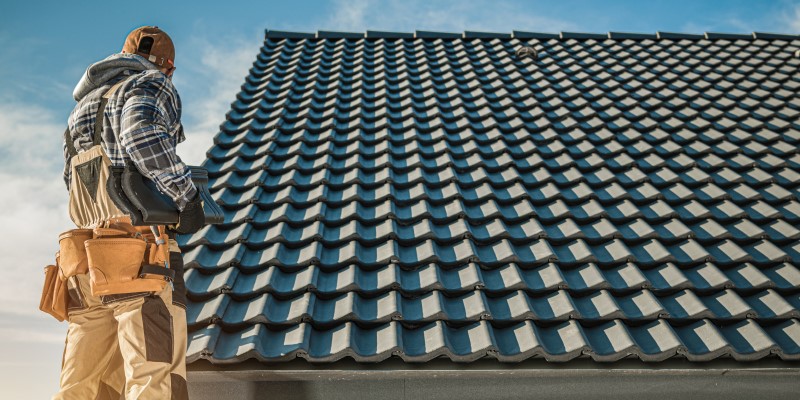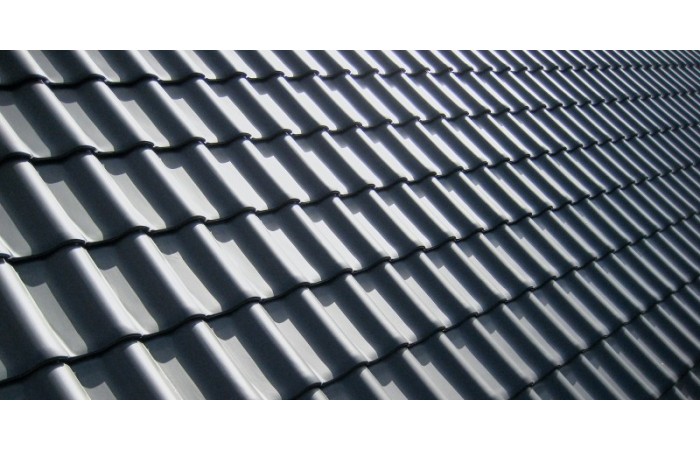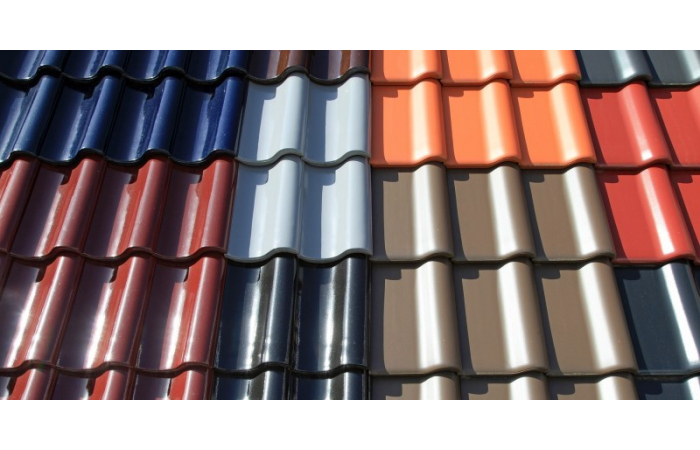What Types of Roof Tiles Are There?

With such a variety of different roof tile options now available, it can be tricky to narrow down to the best type of tile for your roof. From traditional clay tiles to contemporary synthetic slates, there are many styles and materials available, each creating its own unique look for your home. It is important to weigh up the practical benefits of each tile, considering factors such as durability, longevity, ease of installation, maintenance required, weather resistance etc to figure out which is the best fit for your property.
In this article, we will take you through the various types of roofing tiles out there and highlight the features, benefits and drawbacks of each to give you a clearer picture.
Types of Roof Tiles
Metal Roof Tiles
Benefits
With their robust strength and impressive lifespan, the metal roof tile has become an increasingly popular choice for many homeowners around the country. Featuring steel, aluminium, zinc and copper cores, metal tiles boast incredibly tough resilience whilst maintaining a structure up to seven times lighter than concrete and clay alternatives. They tend to last for up to 40-70 years so are extremely durable and perfect for those in search of a long-term roofing solution.
With correct installation and adequate care, you won’t have to worry about the weather causing havoc with your roof structure. Metal tiles can easily survive stormy conditions plus are resistant to fire, mildew, rot and insect infestation.
Thanks to their larger surface span and modernised fitting system, metal roof tiles are also much easier to install, up to 10 times faster than other conventional options. They are environmentally friendly and very energy efficient, reflecting heat away from the surface to keep the building below cool.
Things to Consider
Metal roof tiles are not completely immune to damage and can experience denting if contact is made with enough force. Denting can often be caused by very large pieces of ice or hail hitting the tile surface so checking for damage after an especially heavy storm may be required.
Metal roof tiles are also often the slightly pricier option in comparison to traditional materials. However, as they do offer such an impressive lifespan, the value for money and in the long run may be enough to appease this original higher cost.
Although generally pretty quiet, metal tiles can be especially noisy in the midst of very stormy conditions.
Great Examples
Suitable for a wide range of roofing applications, the Britmet Plaintile Plus offers exceptional resistance levels with only very minimal upkeep and extremely straightforward installation. There are a multitude of stunning natural colours to choose from, each supplied with a full 40-year guarantee by the manufacturer.
With a top-of-the-range design and flexible versatility, the Britmet Slate 2000 Plus is the ideal match for hundreds of different projects. Each tile is manufactured using long-lasting, fully resilient materials and perfectly encapsulates the feeling of real slate with a range of gorgeous colours to choose from.
Clay Roof Tiles
Benefits
Widely used for thousands of years in roofing, clay tiles are a hugely popular choice thanks to their beautifully timeless look, dependable resilience and unique versatility. They are ideal for enhancing the curb appeal of your home with a multitude of colours and profiles available.
Robust and durable, clay roof tiles are crafted to hold up well against harsh weather conditions and even fire. Generally, clay tiles can last at least 50-60 years, however with correct installation and maintenance, they have been known to last over a hundred.
Creating an eco-friendly home is now a priority for many. Thankfully, clay roof tiles have a low environmental impact and are pretty energy efficient. They have an absorption rate of only 6% which means water intake is less than concrete alternatives.
Things to Consider
Although, generally very durable, clay tiles can be fragile if not treated with adequate care so heavy foot traffic is advised against. In particularly heavy storms, clay tiles can loosen and fall from the roofing structure which may require replacements at extra cost.
Clay is also heavier than lightweight modern alternatives which may mean that structural reinforcement could be required to ensure that your home can handle the weight.
Installation can be pretty tricky as the tiles must be precisely measured, correctly laid in a specific pattern and then re-checked to ensure no moisture leaks through the tile structure.
Great Examples
The Redland Rosemary Traditional Tile is a bestseller thanks to its unique blend of traditional clay aesthetics and contemporary manufacturing techniques. These high-quality tiles offer maximum resistance and durability whilst creating a beautifully natural look, suited to a wide range of properties.
Simple to install, highly durable and beautifully finished, the Sandtoft County Pantile creates a clean and traditional look that lasts. Weighing just 2.7kg, this lightweight clay tile is easy to handle plus features smart double interlocking bars. Each tile is manufactured using natural alluvial Humber Clay, a top-grade material with excellent longevity and resilience.
Concrete Roof Tiles
Benefits
Hugely popular across the UK, concrete roofing tiles offer a versatile range of colours, profiles and finishes to perfectly suit any kind of property. Through intelligent design, the concrete can be manufactured to resemble slate, shingle and even wood without the practical disadvantages of these less robust materials.
These hugely durable roof tiles offer top-grade resilience against wind, rain, hail, snow, ice and even fire. Most are known to last for well over 60 years with only minimal maintenance required. If replacements are ever needed, the process is very quick and straightforward thanks to convenient modern fitting techniques.
Concrete roof tiles are another great choice for those looking to build an eco-friendly home. None of the manufacturing techniques or materials utilised within the construction of concrete tiles is environmentally damaging, plus concrete can often be made using recycled materials, increasing sustainability further.
Things to Consider
Concrete is one of the heaviest choices of material for your roof. The roof structure may need reinforcement to safely support the weight and for structurally vulnerable buildings, concrete tiles may not be a suitable option.
Although very durable, concrete tiles are not 100% wind resistant so loosening or breakage in very high winds may sometimes occur. They can also be prone to weathering when impacted by large volumes of rain. Concrete tiles do absorb water so staining and moss/mildew growth can occur, tainting the clean appearance.
Great Examples
Available in a gorgeous selection of colours and finishes, the Redland 50 Double Roman creates the perfect traditional roof, to blend beautifully into any environment. Vigorously tested for optimum durability, the Redland 50’s are proven to securely withstand all weather conditions whilst remaining robust and weathertight. They are ideal for both avid DIYers and roofing professionals thanks to an innovative interlocking installation system.
The Marley Ludlow Plus is a small format tile, designed with a balanced mix of functionality and aesthetics. It is ideal for both contemporary and traditional properties with a range of stunning natural colours available and A+ environmental credentials.
Slate Roof Tiles
Benefits
One of the main selling points for slate roofing is of course its stunning appearance. Whether fitted on a traditional or contemporary property, slate roof tiles boast a natural look that appeals to many homeowners across the country. There are a multitude of types and colours available, each distinctive in its own way to create a timeless aesthetic that is unique to your home.
Perhaps surprisingly, slate does offer fantastic longevity for your roof structure, lasting anywhere from 50 to even 100 years with the correct installation and care. Slates are also fully fire resistant making them ideal for hot climate areas prone to wildfires.
As slate is a naturally-occurring material with little processing involved in the crafting process, slate roof tiles produce very few carbon emissions, making them a more eco-friendly option than alternative tiles. They can even be recycled at the end of their lifespan by utilising them in other home projects thanks to their versatility.
Things to Consider
Unfortunately, slate tiles are one of the most expensive roofing materials that you can buy. Although, when considering they can last up to 100 years in some cases, some find that the initial investment is worth it for the overall longevity.
Although slate tiles are generally very durable, they can be easily damaged under foot traffic. This may be an issue if a contractor requires access to your roof and could require replacements.
Slate tiles are also extremely heavy. Often, properties will require reinforcements before installation to make the structure safe to handle the extra weight, which adds extra time and cost to the project.
It can be tricky to find a roofer qualified to fit a slate roof. Slate tiles require a specialist contractor with knowledge of the correct installation techniques to ensure your roof is fitted to a high-quality.
Great Examples
Combining lightweight modern design with Welsh natural beauty, the Redland Cambrian Slate is the perfect fit for any contemporary or traditional home. Welsh slate is merged with other resilient materials to create a durable and robust structure that remains weathertight all year round.
The Cembrit Glendyne is a tile renowned for its strength, durability and natural beauty. Often used on prestigious monuments and buildings around the world, this high-strength slate tile provide optimum resistance against sunlight, ultraviolet and even acid rain. It comes complete with a full 75-year guarantee but has been known to last well over 90 years.
Plastic Roof Tiles
Benefits
Plastic roofing tiles are ideal for those who want the natural slate aesthetic minus the practical issues of the real thing. In comparison to slate, the synthetic alternative is considerably lighter for easier installation and compatibility with a wider range of roof types. Plastic is also far more cost-effective in both material and fitting costs.
Available in a multitude of colours, finishes and forms, synthetic tiles can be utilised to create a wide variety of looks for any roof type. They are designed to closely resemble raw materials so are ideal for both contemporary and traditional properties.
Durability-wise, plastic tiles are considerably more resilient and robust than slate. They are very hard-wearing and resistant to harsh winds, snow, rain and even UV radiation. The material is impact resistant and fully walkable, so you won’t have to worry about cracks or damage caused by falling objects or foot traffic. Better yet, they are also less susceptible to discolouration over time so you can maintain the ‘brand new’ look for twice the time with half the maintenance.
Most plastic roof tiles are now manufactured using sustainable materials and are completely recyclable at the end of their lifespan. This makes them perfect for those looking to create a more environmentally conscious home.
Drawbacks
Although generally very durable, synthetic tiles unfortunately do not hold up well with fire. Typically, rubber tiles only have about a C class fire rating, however, this can differ from brand to brand. To ensure optimum safety for your property, this should be a factor to consider when choosing your plastic tiles.
Typically, plastic roof tiles have a lifespan of around 20-60 years. In comparison, real slates have been known to last over 100 hundred years with correct installation and care. Longevity will really depend on the quality of the materials and manufacturing, so you may have to spend a little more if you want a longer-lasting roof life.
Great Examples
Available in a gorgeous selection of natural colours with a riven, authentic look, Britmet LiteSlate - Lightweight Synthetic Slate Tile is the perfect fit for both modern and classic properties. At only 15.4kg per square meter, this high-quality tile is brilliantly lightweight for easy transportation, handling and installation. It is compatible with roof pitches between 14° and 90° and has a life expectancy of 40 years.
Designed to appear virtually indistinguishable from real slate, Tapco Synthetic Slate Tile - Pewter Grey boast a natural, riven edged form and is available in a range of stunning slate colours. It weighs as little as 12kg per square meter plus is BBA approved and CE marked, offering impressive durability, longevity and resilience.
Roof Shingles
Benefits
Available in a selection of materials including felt, metal and cedar, roof shingles are designed to suit virtually any property. They are ideal for both cladding projects and pitched roofing applications, compatible with roof pitches up to 90°. Whether you are an experienced tradesperson or DIY homeowner, roof shingles are quick and easy to transport, handle and install thanks to their practical, lightweight design.
Highly versatile, roofing shingles are perfect for contemporary and traditional properties, leisure and industrial buildings, sheds, outbuildings, offices, garages and more. They come in a multitude of shapes, each designed to give your roof a unique and attractive look.
With a close resemblance to traditional roofing tiles, square shingles create a classic, polished aesthetic and are a prevalent choice across the UK. Hexagonal roof shingles are growing in popularity thanks to a contemporary honeycomb design that gives your roof an eye-catching, modern appeal. However, the abstract roof shingle is the choice to go with if you are hoping to create a truly distinctive and creative contemporary look.
Drawbacks
Although dependant on the type of shingle material you go for, roof shingles can be more suspectable to damage caused by rough weather conditions. Their lightweight build can offer less resilience against harsh winds, causing the shingles to be completely ripped off the roofing structure.
Roof shingles may also boast a shorter lifespan than other roofing alternatives. Cedar shingles generally last around 20-30 years and felt roughly 30 years. However, with the correct care, metal shingles can last over 50 years and up so longevity does depend on the material used and manufacturing quality.
Great Examples
Made from 100% Blue label Heartwood, the Marley Western Red Cedar Wood Shingles create a stunning, distinctive look that blends beautifully into any natural environment. With one of the lowest carbon footprints of any building material, cedar wood shingles are fully renewable and sustainable. They are preservative treated for optimum durability and come complete with a full 40-year guarantee.
The bestselling Coroshingle - Roof Shingles are available in a sleek selection of colours with a robust and sturdy build for optimum durability. Each lightweight shingle strip utilises an easy-to-use interlocking system for fast and simple installation by homeowners or tradespeople.
Cost effective and easy to install, the Britmet - Lightweight Metal Roof Shingle is a stylish yet practical choice for a multitude of roofing applications. Each lightweight shingle incorporates a smart hidden fixing system for a polished final result plus is guaranteed for a full 40-years, ensuring optimum durability and weather resistance.
Fibre Cement
Benefits
Similar in aesthetics to natural slate, fibre cement tiles bring a refined touch of elegance to any property for just a fraction of the price. Obtainable in multiple colours, forms and finishes, fibre cement tiles add value, style and kerb appeal to your property, all whilst maintaining great durability and weather resistance.
With a build up to six times lighter than concrete, fibre cement tiles can be easily installed on a multitude of structures without additional support. They are one of the most cost-effective roofing options out there, making them popular for both commercial and residential properties as well as sheds, garages and extensions.
Drawbacks
Although similar in aesthetics to slate, fibre cement, unfortunately, doesn’t boast the same impressive longevity. In comparison, slate can last for 100+ years, whereas fibre cement offers a lifespan of around 30. A combination of weathering and impact damage can cause fibre cement to break or loosen, hence lessening life expectancy.
Great Examples
Contemporary in appearance with a double lap fixing method, the Cembrit Jutland Slates offer the perfect balance of style and practicality. Each tile comes pre-drilled and ready to fit, cutting installation time in half and saving on labour costs. They are a high-quality, low cost option suitable for a range of complex projects with a guarantee of a full 30 years.

